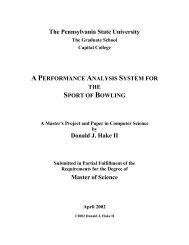k-Nearest Neighbor Classification on Spatial Data Streams Using P ...
k-Nearest Neighbor Classification on Spatial Data Streams Using P ...
k-Nearest Neighbor Classification on Spatial Data Streams Using P ...
Create successful ePaper yourself
Turn your PDF publications into a flip-book with our unique Google optimized e-Paper software.
2. P-tree <strong>Data</strong> Structures<br />
Most spatial data comes in a format called BSQ for Band Sequential (or can be easily<br />
c<strong>on</strong>verted to BSQ). BSQ data has a separate file for each band. The ordering of the<br />
data values within a band is raster ordering with respect to the spatial area represented<br />
in the dataset. We divided each BSQ band into several files, <strong>on</strong>e for each bit positi<strong>on</strong><br />
of the data values. We call this format bit Sequential or bSQ [6, 9, 10]. A Landsat<br />
Thematic Mapper satellite image, for example, is in BSQ format with 7 bands,<br />
B 1 ,…,B 7 , (Landsat-7 has 8) and ~40,000,000 8-bit data values. A typical TIFF image<br />
aerial digital photograph is <strong>on</strong>e file c<strong>on</strong>taining ~24,000,000 bits ordered by itpositi<strong>on</strong>,<br />
then band and then raster-ordered-pixel-locati<strong>on</strong>.<br />
We organize each bSQ bit file, B ij (the file c<strong>on</strong>structed from the j th bits of i th band),<br />
into a tree structure, called a Peano Count Tree (P-tree). A P-tree is a quadrant-based<br />
tree. The root of a P-tree c<strong>on</strong>tains the 1-bit count, called root count, of the entire bitband.<br />
The next level of the tree c<strong>on</strong>tains the 1-bit counts of the four quadrants in<br />
raster order. At the next level, each quadrant is partiti<strong>on</strong>ed into sub-quadrants and<br />
their 1-bit counts in raster order c<strong>on</strong>stitute the children of the quadrant node. This<br />
c<strong>on</strong>structi<strong>on</strong> is c<strong>on</strong>tinued recursively down each tree path until the sub-quadrant is<br />
pure (entirely 1-bits or entirely 0-bits). Recursive raster ordering is called the Peano<br />
or Z-ordering in the literature – therefore, the name Peano Count trees. The P-tree for<br />
a 8-row-8-column bit-band is shown in Fig. 1.<br />
1 1 1 1 1 1 0 0<br />
1 1 1 1 1 0 0 0<br />
1 1 1 1 1 1 0 0<br />
1 1 1 1 1 1 1 0<br />
1 1 1 1 1 1 1 1<br />
1 1 1 1 1 1 1 1<br />
1 1 1 1 1 1 1 1<br />
0 1 1 1 1 1 1 1<br />
55<br />
____________/ / \ \_________<br />
/ _____/ \ ___ \<br />
16 ____8__ _15__ 16<br />
/ / | \ / | \ \<br />
3 0 4 1 4 4 3 4<br />
//|\ //|\ //|\<br />
1110 0010 1101<br />
m<br />
_____________/ / \ \_________<br />
/ ____/ \ ____ \<br />
1 ____m__ _m__ 1<br />
/ / | \ / | \ \<br />
m 0 1 m 1 1 m 1<br />
//|\ //|\ //|\<br />
1110 0010 1101<br />
Fig. 1. 8-by-8 image and its P-tree (P-tree and PM-tree)<br />
In this example, root count is 55, and the counts at the next level, 16, 8, 15 and 16,<br />
are the 1-bit counts for the four major quadrants. Since the first and last quadrant is<br />
made up of entirely 1-bits, we do not need sub-trees for these two quadrants.<br />
For each band (assuming 8-bit data values), we get 8 basic P-trees. P i,j is the P-tree<br />
for the j th bits of the values from the i th band. For efficient implementati<strong>on</strong>, we use<br />
variati<strong>on</strong> of basic P-trees, called Pure Mask tree (PM-tree). In the PM-tree, we use a<br />
3-value logic, in which 11 represents a quadrant of pure 1-bits, pure1 quadrant, 00<br />
represents a quadrant of pure 0-bits, pure0 quadrant, and 01 represents a mixed<br />
quadrant. To simplify the expositi<strong>on</strong>, we use 1 instead of 11 for pure1, 0 for pure0,<br />
and m for mixed. The PM-tree for the previous example is also given in Fig. 1.<br />
P-tree algebra c<strong>on</strong>tains operators, AND, OR, NOT and XOR, which are the pixelby-pixel<br />
logical operati<strong>on</strong>s <strong>on</strong> P-trees. The AND/OR operati<strong>on</strong>s <strong>on</strong> PM-trees are<br />
shown in Fig. 2. The AND operati<strong>on</strong> between two PM-trees is performed by ANDing
















